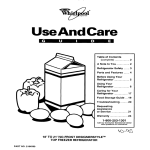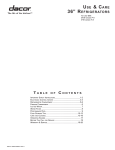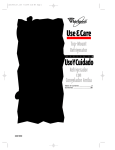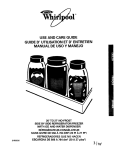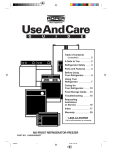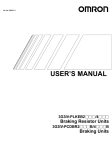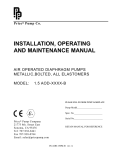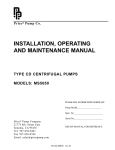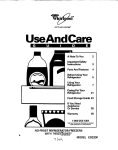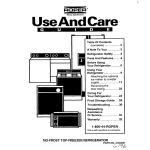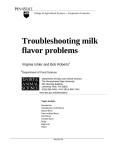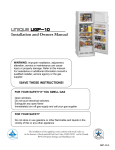Download Whirlpool ED20DFXEB00 User's Manual
Transcript
® Home Appliances UseAndCare G U I D E Table of Contents (complete) .................. 2 A Note to You ................ 2 Refrigerator Safety ....... 3 Parts and Features ....... 4 Installing Your Refrigerator ................... 5 Using Your Refrigerator ................. 11 Caring for Your Refrigerator ................. 23 Food Storage Guide ... 26 Troubleshooting ......... 28 Requesting Assistance or Service .................... 29 Warranty ...................... 32 1-800-253-1301 Call our Consumer Assistance Center with questions or comments. 24'' DEEP FREESTANDING/BUILT-IN SIDE BY SIDE FREEZER REFRIGERATOR PART NO. 4343601/12100701S Table of Contents Page A Note to You ............................................................ 2 Page Adjusting the meat drawer temperature ............... 14 Refrigerator Safety .................................................... 3 Removing the crispers and crisper covers ........... 15 Parts and Features .................................................... 4 Adjusting the crisper humidity control .................. 15 Installing Your Refrigerator ..................................... 5 Removing the freezer basket ............................... 16 Cleaning your refrigerator ...................................... 5 Removing the freezer shelf .................................. 16 Removing the wooden base .................................. 6 Using the utility compartment .............................. 16 Leveling it............................................................... 6 Using the ice and water dispensing system......... 17 Removing the doors and handles .......................... 7 Using the automatic ice maker ............................ 19 Aligning the doors .................................................. 7 Removing the ice maker storage bin ................... 20 Attaching the ice maker to a water supply ............. 8 Removing the base grille ..................................... 20 Plugging it in ........................................................ 10 Changing the light bulbs ...................................... 21 Using Your Refrigerator ......................................... 11 Understanding the sounds you may hear ............ 22 Setting the controls .............................................. 11 Saving energy ...................................................... 22 Changing the control settings .............................. 11 Caring for Your Refrigerator .................................. 23 Removing the snap-on door trivet ........................ 12 Food Storage Guide ................................................ 26 Adjusting the door bins ........................................ 12 Troubleshooting ...................................................... 28 Adjusting the cantilever refrigerator shelves ........ 13 Requesting Assistance or Service ........................ 29 Removing the temperature controlled meat drawer and cover ........................................ 14 Warranty ................................................................... 32 A Note to You Thank you for buying a WHIRLPOOL® appliance. Because your life is getting busier and more complicated, WHIRLPOOL Refrigerators are easy to use, save time, and help you manage your home better. To ensure you enjoy years of trouble-free operation, we developed this Use and Care Guide. It contains valuable information about how to operate and maintain your appliance properly and safely. Please read it carefully. Also, please complete and mail the Ownership Registration Card provided with your appliance. This card helps us notify you about any new information on your appliance. Please record your model’s information. Whenever you call to request service on your appliModel Number ___________________________________ ance, you need to know your complete model number Serial Number ___________________________________ and serial number. You can find this information on the Purchase Date ___________________________________ model and serial number label (see diagram on page 4 for location of label). Dealer Name ____________________________________ Please also record the purchase date of your appliDealer Address __________________________________ ance and your dealer’s name, address, and telephone Dealer Phone ____________________________________ number. Keep this book and the sales slip together in a safe place for future reference. Our Consumer Assistance Center number is tollfree from anywhere in the U.S.A. 24 hours a day. 2 1-800-253-1301 Refrigerator Safety Your safety is important to us. This guide contains statements under warning symbols. Please pay special attention to these symbols and follow any instructions given. Here is a brief explanation of the use of the warning symbol. wWARNING This symbol alerts you to such dangers as fire, electrical shock, burns, and personal injury. IMPORTANT SAFETY INSTRUCTIONS wWARNING To reduce the risk of fire, electrical shock, or injury when using your refrigerator, follow these basic precautions: • Read all instructions before using the refrigerator. • Child entrapment and suffocation are not problems of the past. Junked or abandoned refrigerators are still dangerous … even if they will “just sit in the garage a few days.” If you are getting rid of your old refrigerator, do it safely. Please read the enclosed safety booklet from the Association of Home Appliance Manufacturers. Help prevent accidents. • Never allow children to operate, play with, or crawl inside the refrigerator. • Never clean refrigerator parts with flammable fluids. The fumes can create a fire hazard or explosion. • FOR YOUR SAFETY • DO NOT STORE OR USE GASOLINE OR OTHER FLAMMABLE VAPORS AND LIQUIDS IN THE VICINITY OF THIS OR ANY OTHER APPLIANCE. THE FUMES CAN CREATE A FIRE HAZARD OR EXPLOSION. – SAVE THESE INSTRUCTIONS – Help us help you Please: • Install and level the refrigerator on a floor that will hold the weight and in an area suitable for its size and use. • Do not install the refrigerator near an oven, radiator, or other heat source. • Do not use the refrigerator in an area where the room temperature will fall below 55°F (13°C). • Keep the refrigerator out of the weather. • Connect the refrigerator only to the proper kind of outlet, with the correct electrical supply and grounding. (Refer to the Electrical Requirements and Grounding Instructions Sheet.) • Do not load the refrigerator with food before it has time to get properly cold. • Use the refrigerator only for the uses described in this manual. • Properly maintain the refrigerator. • Be sure the refrigerator is not used by anyone unable to operate it properly. 3 Parts and Features This section contains captioned illustrations of your appliance. Use them to become familiar with where all parts and features are located and what they look like. Page references are included for your convenience. NOTE: The model you have purchased may have all or some of the parts and features shown and they may not match the illustration exactly. This manual covers several models. Model and serial number label (on side wall) (p. 2) Control panel (p. 11) Utility compartment (p. 16) Quick Freeze Automatic ice maker (p. 19) Refrigerator shelves (p. 13) Ice bin (p. 20) Door bin (p. 12) Freezer shelves (p. 16) Wine rack Temperature controlled meat drawer (p. 14) Freezer basket (p. 16) Snap-on door trivet (p. 12) Egg bin Humidity controlled crispers (p. 15) Levelers (p. 6) Base grille (p. 20) Control Panel FREEZER 4 REFRIGERATOR 4 CO 6 2 7 1 3 CO ER LD ER LD 5 3 5 6 2 1 7 OFF Freezer control 4 Refrigerator control Installing Your Refrigerator wWARNING Electric Shock Hazard Disconnect the power to the refrigerator before performing any installation steps. Failure to follow this instruction can result in death or electrical shock. When you are installing your refrigerator, allow 1⁄ 2-inch (1.25cm) of space on each side and at the top of the refrigerator for ease of installation. It can be flush against the back wall. Be sure to wear gloves while installing the refrigerator. Cleaning your refrigerator Removing packaging materials Remove tape and any inside labels (except the model and serial number label) before using the refrigerator. To remove any remaining tape or label glue: • Rub briskly with thumb. OR • Apply liquid hand-dishwashing detergent or toothpaste to area before removing glue as described above. Do not use sharp instruments, rubbing alcohol, flammable fluids, or abrasive cleaners. These can damage the material. See “Important Safety Instructions” on page 3. NOTE: Do not remove any permanent instruction labels inside your refrigerator. Do not remove the Tech Sheet fastened under the refrigerator at the front. 5 I NS T A L L IN G YOUR R E F RIGE RATO R Plugging it in Be sure you have a 115 Volt, 60 Hz., AC only 15 or 20 ampere fused and properly grounded electrical supply. It is recommended that a separate circuit serving only this appliance be provided. Use a receptacle which cannot be turned off with a switch or pull chain. Do not use an extension cord. See Electrical Requirements and Grounding Instructions Sheet in your Literature Package. 3-prong grounding type wall receptacle Refrigerator power cord 3-prong grounding plug Removing the wooden base wWARNING Excessive Weight Hazard Use two or more people to move refrigerator. Failure to do so can result in back or other injury. 1. Tape the doors shut with masking tape. 2. Slide an appliance cart under one side of the refrigerator. 3. Wrap the refrigerator with a blanket or pad for protection and thread the cart strap around the refrigerator. Then place foam shipping pads from the shipping carton under the strap and gently tighten. 4. Lower the appliance cart to the floor so the cart handles are resting on the floor. Remove the two bolts from the wooden base and return the appliance cart to the upright position. Remove the appliance strap. 5. Slide the appliance cart under the opposite side of the refrigerator and repeat steps 3-4. When you are finished, throw away the bolts and the wooden base. 6. When you have removed the wooden base, position the refrigerator close to where you want it to be. Make sure that the floor under the refrigerator is secure and can support 945 pounds. NOTE: On model ED20DBXE, see the installation instructions included with the refrigerator for directions on installing the panels and trim on the doors. You can purchase a separate trim kit from your local authorized appliance dealer for model ED20DFXE. Leveling it Move the refrigerator into it’s final position. Use a level and check that refrigerator is level. Do this before attaching the ice maker to a water supply. Level the refrigerator using the four leveling screws two on the right and two on the left. To adjust one or all of these, follow the directions below. 1. Remove base grille (see page 20). 2. Turn the leveling screw clockwise to raise refrigerator or counterclockwise to lower the refrigerator. The top screw will control the rear of the refrigerator and the bottom screw will control the front of the refrigerator. The screws on the right side will control the refrigerator section and the screws on the left will control the freezer section. 3. Check the refrigerator with a level after it is adjusted. 4. If it is level, replace the base grille. IMPORTANT: If refrigerator is not level because of uneven flooring, use shims under the rollers to level it. 6 Leveling screws IN STALLIN G YO U R REFRIG E RAT O R Removing the doors and handles The doors and the handles of your refrigerator can be removed if necessary. To remove the handles: 1. Remove the crushed/cubed ice switch cover on the dispenser by pulling forward. Release the bottom clips on the dispenser cover by placing the taped edge of a putty knife underneath and pulling out. Release the top clips by holding bottom of dispenser cover out and sliding up. 2. On model ED20DBXE, remove the top handle end caps by removing the screws with a Phillips screwdriver. Then remove the door handle inserts by placing a tape covered end of a screwdriver at the top of the door handles in between the handle and insert, and pull the inserts out along the length of the handle. On model ED20DFXE, remove the handles by removing screws with a 1/4-inch (6 millimeter) hex nut driver. 3. Replace handles in the reverse order. To remove the doors: 1. Remove the base grille by holding the end and pulling forward. 2. Loosen the screw from the water tube clamp on the left side of the refrigerator cabinet behind the base grille with a 1/4-inch (6 millimeter) hex nut driver. wWARNING Electrical Shock Hazard Do not remove green ground wire from wire connectors. Doing so can result in death or electrical shock. 3. Remove the top hinge covers by removing the screws with a Phillips screwdriver. Trace around the top hinges with a pencil to help maintain proper alignment when you reassemble the door. 4. Unplug the top hinge wire connectors. 5. Remove the top hinge screws with a 5/16-inch (8 millimeter) hex nut driver, then remove the hinges. 6. Lift the doors off of the bottom hinges. 7. To replace the doors, reverse steps 1-6. Aligning the doors After you have replaced the doors, you should make sure that the doors are properly aligned. 1. Slide the refrigerator into it’s final location and ensure that it is stable. If refrigerator is not stable, remove the base grille and turn the roller adjustment screws clockwise 1⁄4-inch (6 millimeter) with a hex nut driver until the refrigerator is firmly on all rollers. If the floor is uneven, you may need to place shims under the rear rollers to level the refrigerator. 2. Once the refrigerator is stable, make sure that the doors are aligned with each other. If they are not aligned, remove the base grille if it is not already removed, and turn the front roller adjustment screw clockwise with a 1⁄2-inch (6 millimeter) hex nut driver to lower the door. 3. Open and close both doors to make sure that the tops of the doors are aligned. Repeat step 2 until the doors are aligned. 4. Recheck to make sure that the refrigerator is stable, and if not stable, repeat step 1. 5. Once the refrigerator is stable again, make sure that the gap between the doors is consistent from top to bottom. If the gap is consistent, simply replace the base grille. 6. If the gap is not consistent, remove the top hinge covers with a Phillips screwdriver and loosen the screws with a 1/4-inch (6 millimeter) hex nut driver. 7. Push both doors toward the door that is lower and align the tops of the doors with each other while checking that the gap between them is consistent from top to bottom. 8. Tighten the top hinge screws, replace the top hinge covers and base grille. 7 I NS T A L L IN G YOUR R E F RIGE RATO R Attaching the ice maker to a water supply Read all directions carefully before you begin. wWARNING NOTE: Your appliance dealer has a kit available with a 1⁄4-inch saddle type shut-off valve, a union, and copper tubing. Before purchasing, make sure a saddle type valve complies with your local plumbing codes. Do not use piercing type or 3⁄16 -inch saddle valve which reduces water flow and clogs more easily. Cold water supply Electrical Shock Hazard Unplug the refrigerator before installing the ice maker. Failure to do so can result in death or electrical shock. IMPORTANT: • Use copper tubing only and check for leaks. • Install ice maker tubing in areas where temperatures are above freezing. The ice maker water valve contains a flow washer which is used as a water pressure regulator. The ice maker needs to be connected to a cold water line with water pressure limitations of 20-120 psi. If a problem occurs, call your utility company. IMPORTANT: • It may take up to 24 hours for your ice maker to begin producing ice. • If operating the refrigerator before installing the water connection, turn ice maker to the OFF position to prevent operation without water. • All installations must be in accordance with local plumbing code requirements. Tools required: • Tightly fitting gloves • Water bucket • Masking tape • Center punch • Hammer • Towel • Standard screwdriver • Two 1⁄ 2-inch open-end wrenches or two adjustable wrenches • 1⁄4-inch hex nut driver • 1⁄4-inch drill bit • 3⁄8-inch drill bit • Hand drill or electric drill (properly grounded) 8 INSTALLATION IS NOT WARRANTED BY REFRIGERATOR OR ICE MAKER MANUFACTURER. IN STALLIN G YO U R REFRIG E RAT O R Connecting to water line 1. Find a 1⁄2-inch to 11⁄4-inch vertical COLD water pipe near the refrigerator. NOTE: Horizontal pipe will work, but the following precaution must be taken: Drill on the top side of the pipe, not the bottom. This will help keep water away from the drill. This also keeps normal sediment from collecting in the valve. 2. Measure from connection on rear of refrigerator to water pipe. Add 8 feet (2.4 m) to allow for moving refrigerator for cleaning. This is the length of 1⁄ 4-inch O.D. copper tubing you will need for the job (length from connection to water pipe PLUS 8 feet [2.4 m]). Be sure both ends of copper tubing are cut square. 3. Turn OFF main water supply. Turn ON nearest faucet at the lowest elevation long enough to clear line of water. 4. Using a grounded drill, drill a 1⁄4-inch hole on one side of the cold water pipe you have selected. 5. Fasten shut-off valve to cold water pipe with pipe clamp. Be sure outlet end is solidly in the 1⁄4-inch drilled hole in the water pipe and that washer is under the pipe clamp. Tighten packing nut. Tighten the pipe clamp screws carefully and evenly so washer makes a watertight seal. Do not overtighten or you may crush the copper tubing, especially if soft (coiled) copper tubing is used. Now you are ready to connect the copper tubing. 6. Slip compression nut and compression sleeve on copper tubing as shown in diagram. Insert end of tubing into outlet end squarely as far as it will go. Screw compression nut onto outlet end with adjustable wrench. Do not overtighten. Turn ON main water supply and flush out tubing until water is clear. Turn OFF shut-off valve on the water pipe. Coil copper tubing. Vertical cold water pipe Rubber washer Packing nut Pipe clamp 1 ⁄4-inch O.D. copper tubing (length from inlet on rear of refrigerator to water pipe plus 8 feet [2.4 m]) Water shut-off valve* Compression sleeve Compression nut TO REFRIGERATOR ➔ * Controls water supply 9 I NS T A L L IN G YOUR R E F RIGE RATO R Connecting to refrigerator 1. While your refrigerator is away from the wall, remove and save the lower cover by removing the screws. 2. Remove the nut and sleeve from the adapter fitting and slide the brass nut and sleeve over the end of the copper tubing. Insert the copper tubing completely into the adapter fitting and make sure that the hose washer is in place. Tighten the adapter fitting by hand as much as possible, then tighten 1/2 turn with an adjustable wrench. Make sure the copper tubing is secure by pulling on it gently. 3. Turn shut-off valve ON. CHECK FOR LEAKS. TIGHTEN ANY CONNECTIONS (INCLUDING CONNECTIONS AT THE VALVE) OR NUTS THAT LEAK. 4. Replace the lower back cover onto the refrigerator and replace and tighten the screws. Be sure to tuck wires inside the cover. Do not allow wires to be pinched. 5. Create a service loop with the copper tubing to avoid kinks and secure it to the refrigerator cabinet using the “P” clamp. 6. Plug in the refrigerator and recheck for leaks while it is running. Make sure that the water inlet tube in the freezer section stays firmly in place. 7. Reposition the refrigerator against the wall. 10 Using Your Refrigerator To obtain the best possible results from your refrigerator, it is important that you operate it properly. This section tells you how to set the controls, remove and adjust the features in your refrigerator, and how to save energy. Setting the controls FREEZER CO 4 5 3 ER LD 6 2 7 1 OFF REFRIGERATOR CO 4 5 3 ER LD The controls for your refrigerator are located on the upper rear wall of the refrigerator section. The FREEZER control regulates the temperature in the freezer section, and the REFRIGERATOR control regulates the temperature in the refrigerator section. When the FREEZER control is turned to off, neither the REFRIGERATOR nor FREEZER sections will cool. When you plug the refrigerator in for the first time: 1. Set the FREEZER control to 4 (recommended setting). Freezer control settings range from 1 (warmest) to 7 (coldest). 2. Set the REFRIGERATOR control to 4 (recommended setting). Refrigerator control settings range from 1 (warmest) to 7 (coldest). Give the refrigerator 24 hours after connecting to cool down completely. After that, you can adjust the controls as needed. The setting indicated above should be correct for normal household use. Your controls will be set correctly when your milk and juice are as cold as you like and your ice cream is firm. 6 2 1 7 Changing the control settings If you need to adjust temperatures in the refrigerator or freezer, use the settings listed in the chart below as a guide. If you have any questions, call our Consumer CONDITION: Assistance Center number, 1-800-253-1301, from anywhere in the U.S.A. • Wait at least 24 hours between adjustments. REASON: RECOMMENDED SETTINGS: Refrigerator Freezer Refrigerator section too warm • Door opened often • Large amount of food added • Room temperature too warm 5 4 Freezer section too warm • Door opened often • Large amount of food added • Very cold room temperature (can’t cycle often enough) 4 5-6 Refrigerator section too cold • Controls not set correctly for your conditions 3 4 Ice not made fast enough • Heavy ice usage • Very cold room temperature (can’t cycle often enough) 4 6-7 Both sections too warm • Door opened often • Large amount of food added • Very warm or very cold room temperatures 5 5 11 U SI N G Y O U R RE F R IGE R A T OR Removing the snap-on door trivet To remove the trivet: Remove all items from the shelf and lift trivet straight up. To replace the trivet: 1. Line up ends of the trivet with the button on the door liner wall. 2. Push trivet straight down until it snaps securely into place. 3. Replace items on the shelf. Adjusting the door bins To remove the door bins: 1. Remove all items from the bin. 2. Push in on the tab at each side of the bin. 3. Pull bin straight out. To replace the door bins: 1. Line up bin with the tabs on the door liner wall. 2. Push bin straight in until it snaps securely back into place. 3. Replace all items to the bin. 12 U SIN G YO U R REFRIGE RAT O R Adjusting the cantilever refrigerator shelves Adjust the shelves to match the way you use your refrigerator. Glass shelves are strong enough to hold bottles, milk, and other heavy food items. To remove a shelf: 1. Remove items from shelf. 2. Tilt shelf up at front. 3. Lift shelf at back. 4. Pull shelf straight out. To replace a shelf: 1. Guide the rear shelf hooks into the slots in the shelf supports on the back liner wall. 2. Tilt front of shelf up until hooks drop into slots. 3. Lower front of shelf to a level position. To slide shelf out : • Carefully pull front of shelf toward you. To slide shelf in: • Push shelf in until it stops. 13 U SI N G Y O U R RE F R IGE R A T OR Removing the temperature controlled meat drawer and cover To remove the meat drawer: 1. Slide meat drawer straight out to the stop. 2. Lift the front slightly. 3. Slide out the rest of the way. 4. Replace in reverse order. Make sure boot is over air inlet in side wall. rol n Cont Chillh n n n Low Hig To remove the cover: 1. Remove meat drawer. 2. Lift front of cover off supports. 3. Lift cover out by pulling up and out. To replace the cover: 1. Fit back of cover into notch supports on walls of refrigerator. 2. Lower front into place. 3. Replace meat drawer. Adjusting the meat drawer temperature Cold air from the freezer flows into the meat drawer. This helps keep the meat drawer colder than the rest of the refrigerator for better storage of meats. Slide the control from side to side to increase or decrease the temperature in the meat drawer. 14 U SIN G YO U R REFRIGE RAT O R Removing the crispers and crisper covers To remove the crisper: 1. Slide crisper straight out to the stop. 2. Lift the front and slide out the rest of the way. 3. Replace in reverse order. Pull out to the stop, lift the front, and pull again. 20 Humidity Control Low High Humidity Control To remove the cover: 1. Hold cover firmly with both hands and lift front of cover off supports. 2. Lift cover out by pulling up and out. To replace the cover: 1. Fit back of cover into notch supports on walls of refrigerator. 2. Lower front into place. 20 Humidity Control Low High Remove the glass insert. Lift the cover front, then the back. NOTE: Handle glass insert with care. It is heavy. Humidity Control Adjusting the crisper humidity control You can control the amount of humidity in the moisture-sealed crisper. Adjust the control to any setting between LOW and HIGH. • LOW (open) lets moist air out of the crisper for best storage of fruits and vegetables with skins. • HIGH (closed) keeps moist air in the crisper for best storage of fresh, leafy vegetables. Humidity Control High Low 15 U SI N G Y O U R RE F R IGE R A T OR Removing the freezer basket The wire basket is designed to be easily adjusted and to slide out for access to items at the back of the basket. To remove the basket, lift up and pull the basket all the way out. To replace the basket, place the basket on the side rails and push it back until the round knob is behind the stop rail. Removing the freezer shelf To remove the shelf, lift up and pull the shelf all the way out. To replace the shelf, place the shelf on the side rails and push it back until the round knob is behind the stop rail. Using the utility compartment The door on your utility compartment and the shelf are removable for easy access and cleaning. To remove the door, open, push in slightly near the hinges and pull out. To remove the shelf, push in on tab at each side and pull straight out. Replace both in the reverse order. 16 U SIN G YO U R REFRIGE RAT O R Using the ice and water dispensing system The ice dispenser Ice dispenses from the ice maker storage bin in the freezer. When you press the dispenser bar, a trapdoor opens in a chute between the dispenser and the ice bin. Ice moves from the bin and falls through the chute. When you release the dispenser bar, a buzzing sound may be heard for a few seconds as the trapdoor closes. The dispenser system will not operate when the freezer door is open. For crushed ice, cubes are crushed before being dispensed. This may cause a slight delay when dispensing crushed ice. Noise from the ice crusher is normal, and pieces of ice may vary in size. When changing from CRUSHED to CUBED, a few ounces of crushed ice will be dispensed along with the first cubes. wWARNING Cut Hazard Use a sturdy glass when dispensing ice or water. Failure to do so can result in cuts. To dispense ice: 1. For cubed ice, move Ice Selector Switch to CUBED position. CRUSHED • CUBED For crushed ice, move Ice Selector Switch to CRUSHED position. CRUSHED • CUBED 2. Press a sturdy glass against the ice dispenser bar. Hold glass close to dispenser opening so ice does not fall outside of glass. 3. Remove the glass to stop dispensing. NIGHT LITE CRUSHED • CUBED ICE CHILLED WATER NOTE: The first few batches of ice may have an offflavor from new plumbing and parts. Throw the ice away. Also, take large amounts of ice from the ice bin, not through the dispenser. 17 U SI N G Y O U R RE F R IGE R A T OR The water dispenser Chilled water comes from a tank behind the meat drawer. It holds approximately 11⁄2 quarts (1.5 L). When the refrigerator is first hooked up, press the water dispenser bar with a glass or jar until you draw and discard 2 or 3 quarts (1.9 to 2.8 L). The water you draw and discard rinses the tank and pipes. Allow several hours to cool a new tankful. NOTE: The small tray beneath the dispenser is designed to evaporate small spills. There is no drain in this tray. Do not pour water into it. To dispense water: 1. Press a sturdy glass against the water dispenser bar. 2. Remove the glass to stop dispensing. NIGHT LITE CRUSHED • CUBED ICE CHILLED WATER NOTE: Dispense enough water every week to maintain a fresh supply. The dispenser light A light is activated when dispensing ice or water and an automatic night light will come on when the room becomes dark. NIGHT LITE Solving common ice and water dispenser problems PROBLEM POSSIBLE CAUSE/SOLUTION Ice dispenser will not work • Freezer door is open. • Ice bin not properly installed. Make sure the bin is pushed in all the way. • Wrong ice in bin. Only use crescents from the ice maker. Shake the bin occasionally to separate cubes and increase storage room. • Dispenser not used for extended periods of time, causing ice cubes to melt together. Dump old ice and make a new supply. Ice dispenser stops working • Ice dispenser bar held in too long. Wait about three minutes for dispenser motor to reset. • Large amounts of ice should be taken from the bin, not through the dispenser. Off taste or odor in ice or water • New plumbing connections can cause discolored or off-flavored ice. Discard the first few batches of ice. • Cubes are stored too long. Throw them away and make a new supply. • Food is not wrapped properly. See page 27 . • Freezer and ice bin need to be cleaned. See page 23. • Water may contain minerals (such as sulfur). A filter may be required to remove them. 18 U SIN G YO U R REFRIGE RAT O R Using the automatic ice maker Here are a few things you will want to know about your automatic ice maker: • The ON/OFF lever is a wire signal arm. Move arm: DOWN to make ice automatically. UP to shut off the ice maker. NOTE: Do not turn ice maker on until it is connected to the water supply. Instructions for ice maker water supply hookup are attached to the back of the refrigerator cabinet. • It is normal for ice crescents to be attached by a corner. They break apart easily. • The ice maker will not operate until the freezer is cold enough to make ice. This can take overnight. • If ice is not being made fast enough and more ice is needed, turn the Freezer Control toward 7. Under normal conditions, the ice maker should produce seven to nine batches of ice within 24 hours. • Good water quality is important for good ice quality. Try to avoid connecting the ice maker to a softened water supply. Water softener chemicals (such as salt from a malfunctioning softener) can damage the ice maker mold and lead to poor ice quality. If a softened water supply cannot be avoided, make sure the water softener is operating properly and is well maintained. Signal arm Solving common ice maker problems PROBLEM POSSIBLE CAUSE/SOLUTION Ice crescents attached at corners • This is normal. They break apart easily. Shake bin occasionally to keep cubes separated. Ice maker will not operate or ice is not made fast enough • ON/OFF lever is in the OFF (up) position. Lower lever to the ON (down) position. Off-taste or odor in ice • New plumbing connections can cause discolored or off-flavored ice. Discard the first few batches of ice. • Freezer is not cold enough. Adjust temperature controls and wait 24 hours. (See “Changing the control settings” on page 11.) • Cubes are stored too long. Throw them away and make a new supply. • Food is not wrapped properly. See page 27. • Freezer and ice bin need to be cleaned. See page 23. • Water may contain minerals (such as sulfur). A filter may be required to remove them. 19 U SI N G Y O U R RE F R IGE R A T OR Removing the ice maker storage bin Remove, empty, and clean the storage bin if: • The ice dispenser has not, or will not, be used for a week or more • A power failure causes ice in the bin to melt and freeze together • The ice dispenser is not used regularly To remove ice bin: 1. Pull the covering panel out from the bottom and slide it to the rear. Quick Freeze 2. Lift the signal arm so it clicks into the OFF (up) position. Ice can still be dispensed, but no more can be made. 3. Lift the front of the storage bin and pull it out. 4. Empty the ice bin. Use hot or warm water to melt the ice if necessary. Never use anything sharp to break up ice in the bin. This can damage the bin and dispenser mechanism. 5. Wash with mild detergent. Rinse well. Do not use harsh or abrasive cleaners or solvents. 6. When replacing the bin, make sure it is pushed in all the way. Then push the signal arm down to the ON position to restart ice production. Removing the base grille To remove the grille: 1. Open both doors. 2. Pull base grille forward to release the clips from the support holes. 3. Do not remove Tech Sheet fastened behind the grille. To replace the grille: 1. Line up grille clips with support holes. 2. Push firmly to snap into place. 3. Close the doors. See cleaning instructions for defrost pan and condenser coils on page 24. 20 U SIN G YO U R REFRIGE RAT O R Changing the light bulbs wWARNING Electrical Shock Hazard Unplug the refrigerator before removing light bulb. Failure to do so can result in death or electrical shock. To change upper refrigerator light: 1. Unplug the refrigerator. 2. Remove the light bulb cover by pushing on the rear corners and slide back. 3. Replace bulb with a 40-watt appliance bulb. 4. Replace the light bulb cover by reversing step 2. 5. Plug in the refrigerator. To change the lower refrigerator light: 1. Unplug the refrigerator. 2. Remove the light bulb cover using a socket wrench. 3. Replace bulb with a 40-watt appliance bulb. 4. Replace light bulb cover using the socket wrench. 5. Plug in the refrigerator. To change the freezer light: 1. Unplug the refrigerator. 2. Remove the ice bucket by lifting and pulling forward. 3. Remove the light bulb cover using a socket wrench. 4. Replace bulb with a 40-watt appliance bulb. 5. Replace light bulb cover using the socket wrench. 6. Plug in the refrigerator. 21 U SI N G Y O U R RE F R IGE R A T OR To change dispenser area light: 1. Unplug the refrigerator. 2. Reach through dispenser area to remove bulb. 3. Replace with a heavy-duty 6-watt bulb, which can be purchased from your Whirlpool dealer. 4. Plug in the refrigerator. NIGHT LITE CRUSHED • CUBED ICE CHILLED WATER Light bulb NOTE: Not all commercial appliance bulbs will fit your refrigerator. Be sure to replace a bulb with one of the same size and shape. Understanding the sounds you may hear Your new refrigerator may make sounds that your old one didn’t. Because the sounds are new to you, you might be concerned about them. Don’t be. Most of the new sounds are normal. Hard surfaces like the floor, walls, and cabinets can make the sounds seem louder. The following describes the kinds of sounds that might be new to you, and what may be making them. Water sounds Slight hum, soft hiss • trickling water • thud (clatter of ice) You may hear buzzing (from the water valve), trickling water, and the clatter of ice dumped into the bin. You may hear the refrigerator’s fan motor and moving air. Clicking or snapping sounds The thermostat makes a definite click when the refrigerator stops running. It also makes a sound when the refrigerator starts. The defrost timer will click when the defrost cycle starts and the heater may sizzle or pop. When the refrigerator stops running, you may hear gurgling in the tubing for a few minutes after it stops. You may also hear defrost water running into the defrost water pan. Ice maker sounds Running sounds Your refrigerator has a high-efficiency compressor and motor. It may have a hum or pulsing sound while operating. Saving energy You can help your refrigerator use less electricity. • Check door gaskets for a tight seal. Level the cabinet to be sure of a good seal. • Clean the condenser coils regularly. • Open the door as few times as possible. Think about what you need before you open the door. Get everything out at one time. Keep food organized so you won’t have to search for what you want. Close door as soon as food is removed. 22 • Go ahead and fill up the refrigerator, but don’t overcrowd it so air movement is blocked. • It is a waste of electricity to set the refrigerator and freezer to temperatures colder than they need to be. If ice cream is firm in the freezer and drinks are as cold as your family likes them, that’s cold enough. • Make sure your refrigerator is not next to a heat source such as a range, water heater, furnace, radiator, or in direct sunlight. Caring for Your Refrigerator Your refrigerator is built to give you many years of dependable service. However, there are a few things you can do to help extend its product life. This section tells you how to clean your refrigerator and what to do when going on vacation, moving, or during a power outage. Cleaning your refrigerator wWARNING Both the refrigerator and freezer sections defrost automatically. However, clean both about once a month to help prevent odors from building up. Wipe up spills right away. To clean your refrigerator, unplug it, take out all removable parts, and clean the refrigerator according to the following directions. Burn Hazard Avoid touching refrigeration tubes near defrost pan. Doing so can cause burns. PART WHAT TO USE HOW TO CLEAN Removable parts (shelves, crisper, etc.) Sponge or cloth with mild detergent and warm water • Hand wash, rinse, and dry thoroughly. Outside Sponge, cloth, or paper towel with mild detergent, warm water, and a good appliance wax (or good auto paste wax) • Wash outside of cabinet. Do not use abrasive or harsh cleaners. Sponge, soft cloth, or paper towel with baking soda or mild detergent and warm water • Wash with mixture of warm water and: – mild detergent, or – baking soda (2 tbs to 1 qt [26 g to .95 L] of water). Inside walls (allow freezer to warm up so cloth won’t stick) • Wipe and dry thoroughly. • Wax painted metal surfaces at least twice a year. Apply wax with a clean, soft cloth. Waxing painted metal surfaces provides rust protection. Do not wax plastic parts. • Wipe and dry thoroughly. Door liners and gaskets Sponge, soft cloth, or paper towel with mild detergent and warm water • Wash, wipe, and dry thoroughly. Plastic parts (covers and panels) Soft, clean sponge or soft, clean cloth with mild detergent and warm water • Wash, wipe, and dry thoroughly. DO NOT USE cleaning waxes, concentrated detergents, bleaches, or cleaners containing petroleum on plastic parts. DO NOT USE paper towels, window sprays, scouring cleansers, or flammable fluids. These can scratch or damage material. See “Important Safety Instructions” on page 3. continued on next page 23 C A R IN G F O R Y OUR RE F R IGE RATO R PART WHAT TO USE HOW TO CLEAN Defrost pan Sponge or cloth with mild detergent and warm water • Remove base grille. (See page 20.) • Reach into small opening at right edge and remove the defrost pan. • Wash, rinse, and dry thoroughly. • Replace defrost pan. Make sure to push it completely into the opening. • Replace base grille. Condenser coils Vacuum cleaner with extended narrow attachment • Remove base grille. • Vacuum coils when dusty or dirty. Coils may need to be cleaned as often as every other month. • Replace base grille. Vacation and moving care Short vacations Moving No need to shut off the refrigerator if you will be away for less than four weeks. 1. Use up any perishables. 2. Freeze other items. 3. Raise signal arm to OFF (up) position. 4. Shut off water supply to the ice maker. 5. Empty the ice bin. When you are moving the refrigerator to a new home: 1. Turn off the water supply to the ice maker at least one day ahead of time. 2. Disconnect the water line. 3. After the last load of ice drops, lift the signal arm to the OFF (up) position. 4. Remove all food from the refrigerator. 5. Pack all frozen food in dry ice. 6. Unplug the refrigerator. 7. Clean it thoroughly. Wipe and dry well. 8. Take out all removable parts, wrap them well, and tape them together so they don’t shift and rattle. 9. Screw in the leveling rollers. 10. Tape the doors shut and tape the power supply cord to the cabinet. When you get to your new home, put everything back and refer to page 5. Long vacations If you will be gone a month or more: 1. Remove all food from the refrigerator. 2. Turn off the water supply to the ice maker at least one day ahead of time. 3. When the last load of ice drops, turn off the ice maker. Make sure all ice is dispensed out of the ice maker mechanism. 4. Unplug the refrigerator. 5. Clean it, wipe, and dry well. 6. Tape rubber or wood blocks to the tops of both doors to prop them open far enough for air to get in. This stops odor and mold from building up. To restart refrigerator, see page 11. 24 CARIN G FO R YO U R REFRIGE RAT O R Power interruptions If electricity goes off, call the power company. Ask how long power will be off. 1. If service will be interrupted 24 hours or less, keep both doors closed. This helps foods stay frozen. 2. If service will be interrupted longer than 24 hours: (a)Remove all frozen food and store in a frozen food locker. OR (b) Place 2 lbs (907 g) of dry ice in freezer for every cubic foot (liter) of freezer space. This will keep food frozen for two to four days. Wear gloves to protect your hands from dry ice burns. OR (c)If neither a food locker nor dry ice is available, use or can perishable food at once. 3. A full freezer stays cold longer than a partly filled one. A freezer full of meat stays cold longer than a freezer full of baked goods. If food contains ice crystals, it may be safely refrozen, although the quality and flavor may be affected. If the condition of the food is poor, or if you feel it is unsafe, dispose of it. Questions? Call our Consumer Assistance Center telephone number, 1-800-253-1301, from anywhere in the U.S.A. 25 Food Storage Guide There is a correct way to package and store refrigerated or frozen food. To keep food fresher, longer, take the time to study these recommended steps. Storing fresh food Wrap or store food in the refrigerator in airtight and moisture-proof material. This prevents food odor and taste transfer throughout the refrigerator. For dated products, check code date to ensure freshness. Butter or margarine Leafy vegetables Cheese Remove store wrapping and trim or tear off bruised and discolored areas. Wash in cold water and drain. Place in plastic bag or plastic container and store in crisper. Store in the original wrapping until you are ready to use it. Once opened, rewrap tightly in plastic wrap or aluminum foil. Vegetables with skins Leftovers (carrots, peppers) Store in crisper, plastic bags, or plastic container. Cover leftovers with plastic wrap or aluminum foil. Plastic containers with tight lids can also be used. Fruit Meat Wash, let dry, and store in refrigerator in plastic bags or crisper. Do not wash or hull berries until they are ready to use. Sort and keep berries in original container in a crisper, or store in a loosely closed paper bag on a refrigerator shelf. Store most meat in original wrapping as long as it is airtight and moisture-proof. Rewrap if necessary. See the following for storage times. When storing meat longer than the times given, freeze the meat. Eggs Ground beef ..... 1-2 days Cold cuts ............. 3-5 days Store without washing in original carton on interior shelf. On some models, an egg storage container is provided for your convenience. Steaks/roasts ... 3-5 days Variety meats ...... 1-2 days Milk Wipe milk cartons. For best storage, place milk on interior shelf. 26 Keep opened butter in covered dish or closed compartment. When storing an extra supply, wrap in freezer packaging and freeze. Chicken ............ 1-2 days Bacon .................. 5-7 days Cured meats ... 7-10 days NOTE: Use fresh fish and shellfish the same day as purchased. FO O D STO RAGE G U I DE Storing frozen food The freezer section is designed for storage of commercially frozen food and for freezing food at home. NOTE: For further information about preparing food for freezing or food storage times, check a freezer guide or reliable cookbook. Packaging The secret to successful freezing is in the packaging. The way you close and seal the package must not allow air or moisture in or out. Packaging done in any other way could cause food odor and taste transfer throughout the refrigerator and drying of frozen food. Packaging recommended for use: • Rigid, plastic containers with tight-fitting lids • Straight-sided canning/freezing jars • Heavy-duty aluminum foil • Plastic-coated paper • Non-permeable plastic wraps (made from saran film) Follow package or container instructions for proper freezing methods. Do not use: • Bread wrappers • Non-polyethylene plastic containers • Containers without tight lids • Wax paper • Wax-coated freezer wrap • Thin, semi-permeable wrap The use of these wrappings could cause food odor, taste transfer, and drying of frozen food. Freezing Do not expect your freezer to quick-freeze any large quantity of food. Put no more unfrozen food into the freezer than will freeze within 24 hours (no more than 2 to 3 lbs of food per cubic foot [907-1,350 g per liter] of freezer space). Leave enough space for air to circulate around packages. Be careful to leave enough room at the front so the door can close tightly. Storage times will vary according to the quality of the food, the type of packaging or wrap used (airtight and moisture-proof), and the storage temperature, which should be 0°F (-17.8°C). 27 Troubleshooting Performance problems often result from little things you can fix without tools. Please read through “Before calling for assistance …” below before calling for service on your appliance. Before calling for assistance … Listed in this chart are the most common problems consumers run into with their appliances. Please read through this and see if it can solve your problem. PROBLEM CHECK THE FOLLOWING Your refrigerator will not operate Is the power supply cord firmly plugged into a live circuit with proper voltage? Has a household fuse or circuit breaker blown/tripped? Is the Refrigerator Control set to the OFF position? The lights do not work Is the power supply cord firmly plugged into a live circuit with proper voltage? Has a household fuse or circuit breaker blown/tripped? Is a bulb burned out? The ice maker does not work Is the freezer cold enough to make ice? It could take overnight for the freezer to reach the proper temperature. Is the ON/OFF lever in the ON (down) position? (See page 19.) Is the water valve turned on? Does the water line have a clog or leak? Dispensers do not work Is the freezer door closed? Unfamiliar sounds or a rattling/ jingling noise Is something on top of or behind the refrigerator? There is water in the defrost pan This is normal on hot, muggy days. Make sure the refrigerator is level so the pan does not overflow. The motor seems to run too much Are the condenser coils dirty? Some new sounds are normal. See “Understanding the sounds you may hear” on page 22. Has the door been opened often? Has a large amount of food been added at one time? The motor naturally runs longer if these things happen. Is the room hot? If the room is too warm, the motor runs longer to keep the unit cool. 28 Requesting Assistance or Service Before calling for assistance or service, please check “Troubleshooting” on page 28. It may save you the cost of a service call. If you still need help, follow the instructions below. For assistance or service: 1. If you need assistance* … Call the Whirlpool Consumer Assistance Center telephone number. Dial toll-free from anywhere in the U.S.A.: 1-800-253-1301 and talk with one of our trained consultants. The consultant can instruct you in how to obtain satisfactory operation from your appliance or, if service is necessary, recommend a qualified service company in your area. If you prefer, write to: Mr. William Clark Consumer Assistance Representative Whirlpool Corporation 2000 North M-63 Benton Harbor, MI 49022-2692 Please include a daytime phone number in your correspondence. 2. If you need service* … Whirlpool has a nationwide network of authorized Whirlpool service companies. Whirlpool service technicians are trained to fulfill the product warranty and provide afterwarranty service, anywhere in the United States. To locate the authorized Whirlpool service company in your area, call our Consumer Assistance Center telephone number (see Step 1) or look in your telephone directory Yellow Pages under: •APPLIANCE-HOUSEHOLDMAJOR, SERVICE & REPAIR - See: Whirlpool Appliances or Authorized Whirlpool Service (Example: XYZ Service Co.) 3. If you need FSP® replacement parts … FSP is a registered trademark of Whirlpool Corporation for quality parts. Look for this symbol of quality whenever you need a replacement part for your WHIRLPOOL® appliance. FSP replacement parts will fit right and work right, because they are made to the same exacting specifications used to build every new WHIRLPOOL appliance. To locate FSP replacement parts in your area, refer to Step 2 or call the Whirlpool Consumer Assistance Center number in Step 1. 4. If you are not satisfied with how the problem was solved … • Contact the Major Appliance Consumer Action Program (MACAP). MACAP is a group of independent consumer experts that voices consumer views at the highest levels of the major appliance industry. • Contact MACAP only when the dealer, authorized servicer, and Whirlpool have failed to resolve your problem. Major Appliance Consumer Action Program 20 North Wacker Drive Chicago, IL 60606 • MACAP will in turn inform us of your action. •WASHING MACHINES & DRYERS, SERVICE & REPAIR - See: Whirlpool Appliances or Authorized Whirlpool Service (Example: XYZ Service Co.) * When asking for help or service: Please provide a detailed description of the problem, your appliance’s complete model and serial numbers, and the purchase date. (See page 2.) This information will help us respond properly to your request. 29 Notes 30 Notes 31 Warranty WHIRLPOOL® Refrigerator Warranty LENGTH OF WARRANTY WHIRLPOOL WILL PAY FOR FULL ONE-YEAR WARRANTY From Date of Purchase FSP® replacement parts and repair labor to correct defects in materials or workmanship. Service must be provided by an authorized Whirlpool service company. FULL FIVE-YEAR WARRANTY From Date of Purchase FSP replacement parts and repair labor to correct defects in materials or workmanship in the sealed refrigeration system. These parts are: 1. Compressor 2. Evaporator 3. Condenser 4. Drier 5. Connecting tubing Service must be provided by an authorized Whirlpool service company. WHIRLPOOL WILL NOT PAY FOR A. Service calls to: 1. Correct the installation of your refrigerator. 2. Instruct you how to use your refrigerator. 3. Replace house fuses or correct house wiring or plumbing. 4. Replace light bulbs. B. Repairs when your refrigerator is used in other than normal, single-family household use. C. Pickup and delivery. Your refrigerator is designed to be repaired in the home. D. Damage to your refrigerator caused by accident, misuse, fire, flood, acts of God, or use of products not approved by Whirlpool. E. Any food loss due to product failure. F. Repairs to parts or systems caused by unauthorized modifications made to the appliance. 6/94 WHIRLPOOL CORPORATION SHALL NOT BE LIABLE FOR INCIDENTAL OR CONSEQUENTIAL DAMAGES. Some states do not allow the exclusion or limitation of incidental or consequential damages, so this exclusion or limitation may not apply to you. This warranty gives you specific legal rights, and you may also have other rights which vary from state to state. Outside the United States, a different warranty may apply. For details, please contact your authorized Whirlpool dealer. If you need service, first see the “Troubleshooting” section of this book. After checking “Troubleshooting” additional help can be found by checking the “Requesting Assistance or Service” section, or by calling our Consumer Assistance Center telephone number, 1-800-253-1301, from anywhere in the U.S.A. PART NO. 4343601/12100701S © 1995 Whirlpool, U.S.A. ® Registered Trademark/TM Trademark of Whirlpool, U.S.A. 10/95 Printed in U.S.A.
































